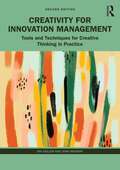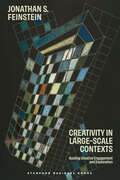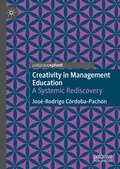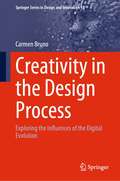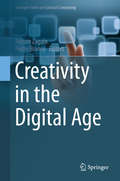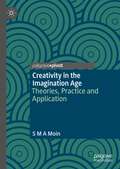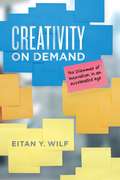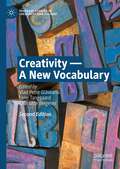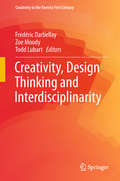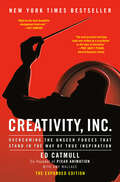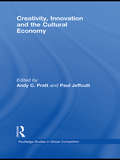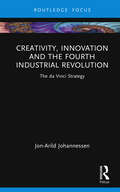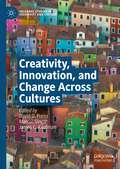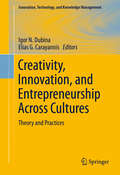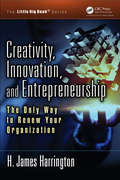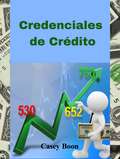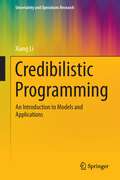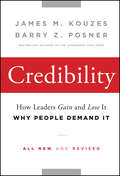- Table View
- List View
Creativity for Innovation Management: Tools and Techniques for Creative Thinking in Practice
by John Bessant Ina GollerCreativity for Innovation Management is a rigorous yet applied guide, which illustrates what creativity is, why it matters, and how it can be developed at both individual and group levels. Unlike many technique-oriented books, this book combines theory with practice, drawing on the latest research in psychology, organisational behaviour, innovation and entrepreneurship. The text provides a range of opportunities to explore innovative and creative processes and develop them via activities linked to relevant tools and techniques, as well as real-life case studies. By working through key competence areas at personal and then team levels, the book demonstrates to students how to build entrepreneurial practices, strong, innovative teams, and organisations that encourage and facilitate innovative thinking. This second edition has been updated throughout, including a new chapter exploring the impact of emerging technologies on creativity, further material on human-centred design, crowdsourcing and collaboration platforms, and cross-cultural differences in innovation management. This textbook is ideal for postgraduate students of Innovation and Creativity and Entrepreneurship, as well as professionals who want to excel by developing and applying their own creativity at work. Online resources complement the book, with access to key tools, techniques, and activities, as well as supporting video and audio material and cases, to support learning and teaching.
Creativity in Large-Scale Contexts: Guiding Creative Engagement and Exploration
by Jonathan S. FeinsteinA new model for smarter creativity Innovators and creators work in cultural, economic, and social contexts that shape their work. These contexts are large-scale, filled with overwhelming multitudes of elements and possibilities—but these contexts can be fruitfully "mined" by creative teams. Creativity in Large-Scale Contexts, by Yale professor Jonathan S. Feinstein, introduces a groundbreaking new "network model" to describe how successful innovation can be focused, generated, and accelerated. The book will help teams and organizations innovate smarter and faster. Feinstein argues that in large-scale contexts creativity happens most efficiently when it is actively "guided" by a creative leader or team. Guiding creativity involves understanding, navigating, and actively using the cultural context, identifying puzzles and opportunities, and spanning these tensions to create novel connections. With thoughtful guidance, creators and creative teams can find their way through the thicket of possibilities faster, smarter, and with less waste. Creativity in Large-Scale Contexts draws on case studies of famous creators including Virginia Woolf, Albert Einstein, Indigenous artist Clifford Possum, transgender activist and engineer Lynn Conway, and Twitter cofounder Jack Dorsey. Empirically grounded, this book will be essential for teaching and managing creativity and innovation and will open new avenues for future intellectual growth and practice in the field.
Creativity in Management Education: A Systemic Rediscovery
by José-Rodrigo Córdoba-PachónThis book proposes a new way to consider creativity in management education, inviting educators to rediscover themselves in the process. To date, creativity in management is a valuable skill, but one which has been institutionalized and subordinated to metrics such as economic growth, knowledge disciplining and employability. After a critical analysis using Foucault’s governmentality to identify how creativity is being organized in management education, this book examines diverse initiatives intended to nurture creativity. Then, and through a systemic recontextualization of governmentality and other notions like play, it provides conceptual and practical guidance derived from the author’s own self-narratives (games) as student and educator. The book concludes with important reflections, implications and guidelines for the nurturing in creativity in management education and life in general. This book will be a valuable reading for creativity and innovation scholars, academics working in management education and students in general.
Creativity in product innovation
by Jacob Goldenberg David MazurskyCreativity in Product Innovation describes a remarkable technique for improving the creativity process in product design. Certain 'regularities' in product development are identifiable, objectively verifiable and consistent for almost any kind of product. These regularities are described by the authors as Creativity Templates. This book describes the theory and implementation of these templates, showing how they can be used to enhance the creative process and thus enable people to be more productive and focused. Representing the culmination of years of research on the topic of creativity in marketing, the Creativity Templates approach has been recognised as a breakthrough in such journals as Science, Journal of Marketing Research, Management Science, and Technological Forecasting and Social Change. It has been successfully implemented through workshops in international companies including Philips Consumer Electronics, Ford Motor Co. , Ogilvy & Mather Worldwide, Kodak, Coca-Cola and many others.
Creativity in the Design Process: Exploring the Influences of the Digital Evolution (Springer Series in Design and Innovation #18)
by Carmen BrunoThe book provides an open and integrated view of creativity in the 21st century, merging theories and case studies from design, psychology, sociology, computer science and human-computer interaction, while benefitting from a continuous dialogue within a network of experts in these fields. An exploratory journey guides the reader through the major social, human, and technological changes that influence human creative abilities, highlighting the fundamental factors that need to be stimulated for creative empowerment in the digital era. The book reflects on why and how design practice and design research should explore digital creativity, and promote the empowerment of creativity, presenting two flexible tools specifically developed to observe the influences on multiple level of human creativity in the digital transition, and understand their positive and negative effect on the creative design process. An overview of the main influences and opportunities collected by adopting the two tools are presented with guidelines to design actions to empower the process for innovation.
Creativity in the Digital Age (Springer Series on Cultural Computing)
by Nelson Zagalo Pedro BrancoThis edited book discusses the exciting field of Digital Creativity. Through exploring the current state of the creative industries, the authors show how technologies are reshaping our creative processes and how they are affecting the innovative creation of new products. Readers will discover how creative production processes are dominated by digital data transmission which makes the connection between people, ideas and creative processes easy to achieve within collaborative and co-creative environments. Since we rely on our senses to understand our world, perhaps of more significance is that technologies through 3D printing are returning from the digital to the physical world. Written by an interdisciplinary group of researchers this thought provoking book will appeal to academics and students from a wide range of backgrounds working or interested in the technologies that are shaping our experiences of the future.
Creativity in the Imagination Age: Theories, Practice and Application
by S M MoinIn the imagination age, organizations need to harness the power of creativity and innovation in order to survive and thrive. Grounded in academic and applied research, this book offers invaluable insights into these concepts from an interdisciplinary perspective. Through compelling narratives, the author critically discusses the theories and models that will empower the thinking of researchers, entrepreneurs and leaders. Revealing how the fourth industrial revolution can put our creative minds into play with enormous opportunities to solve problems and make meaning, the book invites us to debate how human and emerging technologies will write the next chapter of human history. It covers philosophical approaches to creativity, the characteristics of creative teams, the components of individual creativity as well as the role of imagination and associative thinking in fostering creativity and innovation.
Creativity on Demand: The Dilemmas of Innovation in an Accelerated Age
by Eitan Y. WilfBusiness consultants everywhere preach the benefits of innovation—and promise to help businesses reap them. A trendy industry, this type of consulting generates courses, workshops, books, and conferences that all claim to hold the secrets of success. But what promises does the notion of innovation entail? What is it about the ideology and practice of business innovation that has made these firms so successful at selling their services to everyone from small start-ups to Fortune 500 companies? And most important, what does business innovation actually mean for work and our economy today? In Creativity on Demand, cultural anthropologist Eitan Wilf seeks to answer these questions by returning to the fundamental and pervasive expectation of continual innovation. Wilf focuses a keen eye on how our obsession with ceaseless innovation stems from the long-standing value of acceleration in capitalist society. Based on ethnographic work with innovation consultants in the United States, he reveals, among other surprises, how routine the culture of innovation actually is. Procedures and strategies are repeated in a formulaic way, and imagination is harnessed as a new professional ethos, not always to generate genuinely new thinking, but to produce predictable signs of continual change. A masterful look at the contradictions of our capitalist age, Creativity on Demand is a model for the anthropological study of our cultures of work.
Creativity under the Gun at Litmus Corporation
by Teresa M. AmabileTeaches students to diagnose the circumstances under which time pressure can facilitate or hinder creativity. A team's creative "genius", Miles Grady, who previously conceptualized a revolutionary material for an important new product, must now significantly change that material so that the team can create an entirely new business. This early new business development project, while supported by management, has a looming deadline for proof-of-concept. The deadline has already been extended, but the team does not seem close to the breakthrough it needs. The team's leader, Stanley Carmine, who has managed to get a few weeks' extension from management, needs to figure out how best to manage Grady under the looming deadline. He studies Grady's past "daily laboratory logs" to discover the connections, if any, between time pressure, other circumstances, and Grady's level of creativity.
Creativity — A New Vocabulary (Palgrave Studies in Creativity and Culture)
by Vlad Petre Glăveanu Lene Tanggaard Charlotte WegenerCreativity — A New Vocabulary proposes a novel approach to the way in which we talk and think about creativity. It covers a variety of topics not commonly associated with creativity that offer us valuable insights and open up new and exciting possibilities for creative action. This second edition includes six new essays which continue to challenge the traditional vocabulary of creativity and its preference for individuals, brains, cognition, personality, divergent thinking, insight, and problem solving. The book proposes a more dynamic and relational perspective that considers creativity as an embodied, social, material, and cultural process. This book will be useful for a wide range of specialists within the humanities and social sciences, as well as practitioners from applied fields who are looking for novel ways, of thinking about and doing creative work.
Creativity, Design Thinking and Interdisciplinarity (Creativity in the Twenty First Century)
by Frédéric Darbellay Zoe Moody Todd LubartThis book, at the crossroads of creativity, design and interdisciplinary studies, offers an overview of these major trends in scientific research, society, culture and economics. It brings together different approaches and communities around a common reflection on interdisciplinary creative design thinking. This collective effort provides a unique dialogical and convergent space that deals with the challenges and opportunities met by researchers and practitioners working on design thinking, creativity and inter- and transdisciplinarity, or at the interface between these areas.
Creativity, Inc. (The Expanded Edition): Overcoming the Unseen Forces That Stand in the Way of True Inspiration
by Amy Wallace Ed CatmullThe co-founder and longtime president of Pixar updates and expands his 2014 New York Times bestseller on creative leadership, reflecting on the management principles that built Pixar&’s singularly successful culture, and on all he learned during the past nine years that allowed Pixar to retain its creative culture while continuing to evolve.&“Might be the most thoughtful management book ever.&”—Fast Company For nearly thirty years, Pixar has dominated the world of animation, producing such beloved films as the Toy Story trilogy, Finding Nemo, The Incredibles, Up, and WALL-E, which have gone on to set box-office records and garner eighteen Academy Awards. The joyous storytelling, the inventive plots, the emotional authenticity: In some ways, Pixar movies are an object lesson in what creativity really is. Here, Catmull reveals the ideals and techniques that have made Pixar so widely admired—and so profitable. As a young man, Ed Catmull had a dream: to make the first computer-animated movie. He nurtured that dream as a Ph.D. student, and then forged a partnership with George Lucas that led, indirectly, to his founding Pixar with Steve Jobs and John Lasseter in 1986. Nine years later, Toy Story was released, changing animation forever. The essential ingredient in that movie&’s success—and in the twenty-five movies that followed—was the unique environment that Catmull and his colleagues built at Pixar, based on philosophies that protect the creative process and defy convention, such as:• Give a good idea to a mediocre team and they will screw it up. But give a mediocre idea to a great team and they will either fix it or come up with something better.• It&’s not the manager&’s job to prevent risks. It&’s the manager&’s job to make it safe for others to take them.• The cost of preventing errors is often far greater than the cost of fixing them.• A company&’s communication structure should not mirror its organizational structure. Everybody should be able to talk to anybody.Creativity, Inc. has been significantly expanded to illuminate the continuing development of the unique culture at Pixar. It features a new introduction, two entirely new chapters, four new chapter postscripts, and changes and updates throughout. Pursuing excellence isn&’t a one-off assignment but an ongoing, day-in, day-out, full-time job. And Creativity, Inc. explores how it is done.
Creativity, Inc.: Overcoming the Unseen Forces That Stand in the Way of True Inspiration
by Amy Wallace Ed CatmullCreativity, Inc. is a book for managers who want to lead their employees to new heights, a manual for anyone who strives for originality, and the first-ever, all-access trip into the nerve center of Pixar Animation—into the meetings, postmortems, and “Braintrust” sessions where some of the most successful films in history are made. It is, at heart, a book about how to build a creative culture—but it is also, as Pixar co-founder and president Ed Catmull writes, “an expression of the ideas that I believe make the best in us possible.”<P><P> For nearly twenty years, Pixar has dominated the world of animation, producing such beloved films as the Toy Story trilogy, Monsters, Inc., Finding Nemo, The Incredibles, Up, and WALL-E, which have gone on to set box-office records and garner thirty Academy Awards. The joyousness of the storytelling, the inventive plots, the emotional authenticity: In some ways, Pixar movies are an object lesson in what creativity really is. Here, in this book, Catmull reveals the ideals and techniques that have made Pixar so widely admired—and so profitable.<P> As a young man, Ed Catmull had a dream: to make the first computer-animated movie. He nurtured that dream as a Ph.D. student at the University of Utah, where many computer science pioneers got their start, and then forged a partnership with George Lucas that led, indirectly, to his founding Pixar with Steve Jobs and John Lasseter in 1986. Nine years later, Toy Story was released, changing animation forever. The essential ingredient in that movie’s success—and in the thirteen movies that followed—was the unique environment that Catmull and his colleagues built at Pixar, based on philosophies that protect the creative process and defy convention, such as:<P> * Give a good idea to a mediocre team, and they will screw it up. But give a mediocre idea to a great team, and they will either fix it or come up with something better.<P> * If you don’t strive to uncover what is unseen and understand its nature, you will be ill prepared to lead. <P> * It’s not the manager’s job to prevent risks. It’s the manager’s job to make it safe for others to take them.<P> * The cost of preventing errors is often far greater than the cost of fixing them. <P> * A company’s communication structure should not mirror its organizational structure. Everybody should be able to talk to anybody.<P> Chosen for Mark Zuckerberg's "A Year of Books"
Creativity, Inc.: Overcoming the Unseen Forces That Stand in the Way of True Inspiration
by Amy Wallace Ed CatmullFrom Ed Catmull, co-founder (with Steve Jobs and John Lasseter) of Pixar Animation Studios, comes an incisive book about creativity in business—sure to appeal to readers of Daniel Pink, Tom Peters, and Chip and Dan Heath.Creativity, Inc. is a book for managers who want to lead their employees to new heights, a manual for anyone who strives for originality, and the first-ever, all-access trip into the nerve center of Pixar Animation—into the meetings, postmortems, and &“Braintrust&” sessions where some of the most successful films in history are made. It is, at heart, a book about how to build a creative culture—but it is also, as Pixar co-founder and president Ed Catmull writes, &“an expression of the ideas that I believe make the best in us possible.&”For nearly twenty years, Pixar has dominated the world of animation, producing such beloved films as the Toy Story trilogy, Monsters, Inc., Finding Nemo, The Incredibles, Up, and WALL-E, which have gone on to set box-office records and garner thirty Academy Awards. The joyousness of the storytelling, the inventive plots, the emotional authenticity: In some ways, Pixar movies are an object lesson in what creativity really is. Here, in this book, Catmull reveals the ideals and techniques that have made Pixar so widely admired—and so profitable.As a young man, Ed Catmull had a dream: to make the first computer-animated movie. He nurtured that dream as a Ph.D. student at the University of Utah, where many computer science pioneers got their start, and then forged a partnership with George Lucas that led, indirectly, to his founding Pixar with Steve Jobs and John Lasseter in 1986. Nine years later, Toy Story was released, changing animation forever. The essential ingredient in that movie&’s success—and in the thirteen movies that followed—was the unique environment that Catmull and his colleagues built at Pixar, based on philosophies that protect the creative process and defy convention, such as:• Give a good idea to a mediocre team, and they will screw it up. But give a mediocre idea to a great team, and they will either fix it or come up with something better.• If you don&’t strive to uncover what is unseen and understand its nature, you will be ill prepared to lead. • It&’s not the manager&’s job to prevent risks. It&’s the manager&’s job to make it safe for others to take them.• The cost of preventing errors is often far greater than the cost of fixing them. • A company&’s communication structure should not mirror its organizational structure. Everybody should be able to talk to anybody.• Do not assume that general agreement will lead to change—it takes substantial energy to move a group, even when all are on board.
Creativity, Innovation and the Cultural Economy (Routledge Studies in Global Competition)
by Andy C. Pratt Paul JeffcuttThis collection brings together international experts from different continents to examine creativity and innovation in the cultural economy. In doing so, the collection provides a unique contemporary resource for researchers and advanced students. As a whole, the collection addresses creativity and innovation in a broad organizational field of knowledge relationships and transactions. In considering key issues and debates from across this developing arena of the global knowledge economy, the collection pursues an interdisciplinary approach that encompasses Management, Geography, Economics, Sociology and Cultural Studies.
Creativity, Innovation and the Fourth Industrial Revolution: The da Vinci Strategy (Routledge Focus on Business and Management)
by Jon-Arild JohannessenThe most important goals for an organization in the Fourth Industrial Revolution will be innovation and enhanced performance. Creativity is a means for promoting these goals – a creative person is a productive person who uses all their resources to attain specific goals. Da Vinci Creativity should be understood as being focused on improving performance both at individual and organizational levels. Traditional organizations can be hierarchical, and thus rigid, at a time when the external environment is undergoing very rapid change. The aim of this book is to present an organizational model that develops leaders who are able to cope with the demands of the Fourth Industrial Revolution. In light of the increasing levels of innovation being experienced in society around us, Creativity, Innovation and the Fourth Industrial Revolution: The da Vinci Strategy offers an organizational theory that can be applied in the Fourth Industrial Revolution. This book will be of interest to researchers, academics, and students in the fields of leadership, strategy, and technology and innovation management.
Creativity, Innovation, and Change Across Cultures (Palgrave Studies in Creativity and Culture)
by James C. Kaufman Marcos Singer David D. PreissThis book offers interdisciplinary, multicultural, and international perspectives on the interrelation between culture, innovation, change and creative forces. Its wide-ranging contributions present theoretical and empirical approaches and with reference to different domains across disciplines including psychology, education, social sciences, humanities, and engineering. The authors demonstrate how urgent social, environmental, technological, and economic challenges can benefit from individual, and community creativity to effect change. In this volume, “culture” refers to sociocultural differences, educational culture, media culture, organizational culture, technological culture, ethnic differences within a culture, and digital culture. Its contributors offer fresh insights on how creativity, innovation, and change can propel us forward and offer hope for the future across these many different forms of culture. They offer both granular studies of creativity and innovation at work in particular contexts and macro-level discussion on how they affect organizational culture, the culture of a discipline and society at large. This cross-cultural analysis of creativity, innovation and approaches to change will particularly appeal to practitioners and researchers in the fields of psychology, organizational behavior and education.
Creativity, Innovation, and Entrepreneurship Across Cultures: Theory and Practices (Innovation, Technology, and Knowledge Management)
by Elias G. Carayannis Igor N. DubinaThe aim of this volume is to further develop the relationship between culture and manifold phenomena of creativity, innovation and entrepreneurship in order to promote further and better understanding how, why, and when these phenomena are manifested themselves across different cultures. Currently, cross-cultural research is one of the most dynamically and rapidly growing areas. At the same time, creativity, inventiveness, innovation, and entrepreneurship are championed in the literature as the critical element that is vital not just for companies, but also for the development of societies. A sizable body of research demonstrates that cultural differences may foster or inhibit creative, inventive, innovative and entrepreneurial activities; and each culture has its own strengths and weaknesses in these regards. Better understanding of cultural diversity in these phenomena can help to build on strengths and overcome weaknesses. Cross-cultural studies in this field represent a comparatively new class of interdisciplinary research. This is a field where cultural, sociological, psychological, historical, economic, management, technology and business studies closely intersect. In this book, a global team of researchers representing Europe, Asia, and the Americas review, analyze, structure, systematize and discuss various concepts, assumptions, speculations, theories, and empirical research which focus on the effect of national cultures on creativity, invention, innovation, and entrepreneurship. They argue that national culture is not only an extremely important determinant of innovation and business development, but also demonstrate that some aspects relating to these phenomena may be universal among all cultures, thereby identifying those factors that may easily be transferred across cultures from those that are unique to their specific context.
Creativity, Innovation, and Entrepreneurship: The Only Way to Renew Your Organization (The Little Big Book Series)
by H. James HarringtonPeople with ideas are dreamers. People who get things done are doers. One doer is worth eight dreamers. There are three kinds of people who make up an innovator. There are inventors (people who have new and unique ideas), problem solvers (people who have ideas about how to correct a previous error) and entrepreneurs (people who transform ideas into realities). Put them altogether they spell "innovator." Most innovative books today focus on ways to create new and unique ideas; some of them also address problem-solving, but this is less than 10% of the methodologies that the innovator needs to master. The approaches used in this book transform an idea into reality, or to put it another way, deliver innovative products to make a profit for the organization and instill pride in its employees. This means that every step in the process needs to have innovation applied to it in order to meet the expectations and demands of today's sophisticated customer. This book is designed to help the reader and their organization complete the complex process of bringing a new product to market by presenting what is expected at each step in the cycle and providing step-by-step instructions on what to do at each specific step. In large to mid-sized organizations this book is designed to help each individual understand how they fit into the innovative cycle and explains why they should be more creative related to the work they do and more conscious of the contributions they can make. It emphasizes the importance of every individual contributing to the organization's innovative process. The book is designed to help the organization understand its Innovation Systems Cycle. In the early part of the cycle it focuses on weeding out projects that do not have the potential to produce value-added results to the stakeholders. By using the guidelines outlined in this book, an organization can reduce its new project failure rate by as much as 50% which should result in almost doubling the organization’s new product output thereby increasing profits by as much as 15%.
CredEx Fintech: Business Model Transformation During the Digital Era
by Raphael Amit Laura Huang Xu HanFounded in 2010, CredEx has been a fast and constant innovator in the microfinance industry in China. Tang Xia, CEO and co-founder of CredEx, has led the company through a number of profound business model innovations in response to external environment changes, which transformed the company from an offline, operation heavy micro lending company to an online, data driven FinTech company. This case describes CredEx's business model transformation process since its founding and explores the drivers and challenges in different stages of business model innovation and transformation. Ultimately, the case highlights the key capabilities needed to digitize a traditional finance business as well as the organizational changes needed to enable the digitization.
Credem: Banking on Cheese
by Nikolaos Trichakis Emer Moloney Gerry TsoukalasCredem, an Italian regional bank, grants loans to Parmigiano-Reggiano producers and holds the cheese as collateral in its own warehouse during the maturation process, essentially replacing part of the operations for the cheese producers and gaining deep operations expertise.
Credenciales de Crédito
by Casey Boon Balmore de Jesús morenoDescripción del libro: ¿Está buscando una manera de poner más dinero en su bolsillo, mes tras mes? ¡Aprender sobre los diferenciales de crédito puede ser su boleto! Descubra los beneficios de Credit Spreads como su estrategia comercial GO TO. Conozca cómo puede comercializar Credit Spreads fácilmente, sin la necesidad de ser un experto. Cuando se trata de Trading de Opciones, porque Credit Spreads es un tipo de Trading de Opciones, la gente a menudo piensa que es muy difícil y técnico. Este libro pone esa idea a descansar. Verá que Credit Spreads puede ser sencillo y una forma de inversión de bajo riesgo. Este libro es una introducción a los fundamentos de la negociación de Spreads de crédito. Comience con lo básico. Una vez que tenga una comprensión cómoda de cómo funcionan los Spreads de Crédito, habrá comenzado a obtener algunas ganancias. Este método es de bajo riesgo. Una vez que lo configure, puede contar con él para proporcionarle una inyección consistente de dinero extra, ¡para que pueda usarlo como lo desee! Después de que tenga Spreads de crédito generando ingresos para usted, puede decidir si este es el único tipo de negociación que desea hacer o, puede considerar agregar otra forma de negociación . ¡Escala y diversifica! ¡Utilice las ganancias de sus diferenciales de crédito, entonces realmente se vuelve libre de riesgos! Pero solo cuando estés listo. Debido a que los diferenciales de crédito tienen un riesgo tan bajo, son ideales para la jubilación. ¿Quién no debería comprar este libro? Alguien que está buscando un curso práctico. Este no es un curso, es un libro que da los conceptos y fundamentos que subyacen a los diferenciales de crédito. El objetivo es ayudarte a comenzar en tu carrera comercial. ¡Se cómodo, obtenga ganancias!
Credibilistic Programming: An Introduction to Models and Applications (Uncertainty and Operations Research)
by Xiang LiIt provides fuzzy programming approach to solve real-life decision problems in fuzzy environment. Within the framework of credibility theory, it provides a self-contained, comprehensive and up-to-date presentation of fuzzy programming models, algorithms and applications in portfolio analysis.
Credibility
by James M. Kouzes Barry Z. PosnerThe first true revision of the classic book from the bestselling author of The Leadership ChallengeAs the world falls deeper into economic downturns and warfare, the question of credibility (how leaders gain and lose it) is more important than ever. Building on their research from The Leadership Challenge, James Kouzes and Barry Posner explore in Credibility why leadership is above all a relationship, with credibility as the cornerstone, and why leaders must "Say what you mean and mean what you say." This first full revision of the book since its initial publication in 1993 features new case studies from around the world, fully updated data and research, and a streamlined format. Written by the premier leadership experts working today, Credibility: Reveals the six key disciplines that strengthen a leader's capacity for developing and sustaining credibility. Provides rich examples of real managers in actionIncludes updates to?the applications?and researchThis personal, inspiring, and genuine guide helps you understand the fundamental importance of credibility for building personal and organizational success.
Credibility Without Rules? Monetary Frameworks in the Post-Bretton Woods Era
by Curzio Giannini Carlo CottarelliA report from the International Monetary Fund.
